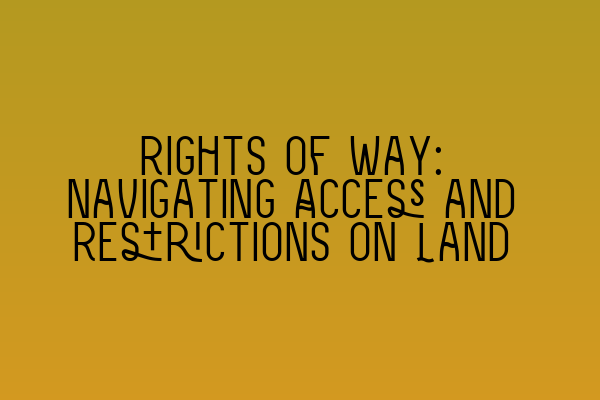Rights of Way: Navigating Access and Restrictions on Land
As a property owner, it is important to understand your rights and obligations when it comes to accessing and using your land. One crucial aspect of property law is the concept of rights of way, which govern the legal right to access and traverse another person’s land. In this blog post, we will explore the intricacies of rights of way, including their types, creation, implications, and enforcement. So, let’s start our journey of understanding and navigating rights of way!
Types of Rights of Way
Rights of way can exist in various forms, providing different levels of access across or over another person’s property. The three main types of rights of way are:
1. Public Rights of Way: These are established by law and grant the general public the right to access certain areas, such as footpaths, bridleways, and byways. Public rights of way are essential for maintaining public access to the countryside and preserving our cultural and historical heritage.
2. Private Rights of Way: Unlike public rights of way, private rights of way are created by agreement or through long-standing use. These rights are specific to individuals or groups and allow them to access specific areas or properties using designated routes. Private rights of way often exist to provide access to properties that are otherwise inaccessible.
3. Easements: Easements are rights that benefit a specific property and allow the owner to do something on the land of another. While rights of way are a subset of easements, easements can also include rights such as the right to lay cables, maintain pipes, or receive light or air across another person’s land.
Creation of Rights of Way
Rights of way can be created in several ways, depending on the circumstances and the nature of the rights. Some common methods of creating rights of way include:
1. Express Grant: A right of way can be created through a written agreement, such as a deed or contract, between the landowner and the party seeking the right. This express grant sets out the terms and conditions of the right, such as its scope, duration, and any associated obligations.
2. Implied Grant: In certain situations, a right of way can be implied based on the historical use and development of the land. For example, if a landowner sells part of their property and there is an existing path across the land leading to the sold portion, an implied grant of a right of way may arise to ensure continued access.
3. Prescription: A right of way can also be established through long-term use without the need for a formal agreement. This is known as a prescriptive right of way, and for it to be legally recognized, the use must be continuous, uninterrupted, and without the landowner’s permission for a specified period of time (usually 20 years).
Implications and Restrictions of Rights of Way
While rights of way can provide valuable access to land, they also come with certain implications and restrictions that you need to consider. Here are a few important points to be aware of:
1. Scope and Limitations: The scope of a right of way is determined by its express terms or the nature of its creation. It is crucial to understand what the right allows and any associated limitations, such as the type of use, the number of users, the permitted times, and any restrictions on vehicles or animals.
2. Maintenance and Repairs: Depending on the agreement or legal framework governing the right of way, the responsibility for maintenance and repairs may fall on either the landowner or the party exercising the right. It is essential to clarify these obligations to avoid disputes in the future.
3. Revocation or Modification: Rights of way can be modified or revoked under certain circumstances, such as when the land is sold, the purpose of the right changes, or it becomes unnecessary or impractical. Understanding the conditions under which a right of way may be altered or terminated is essential for both parties involved.
Enforcement and Resolving Disputes
Like any legal right, rights of way can sometimes lead to disputes between landowners and those exercising the rights. If you find yourself involved in a dispute or needing to enforce your rights of way, it is advisable to seek legal advice promptly.
Professional legal guidance can help assess the validity and scope of the right, negotiate with the parties involved, or, if necessary, take the matter to court. Resolving disputes amicably through negotiation or alternative dispute resolution methods should always be explored before engaging in expensive and time-consuming litigation.
Conclusion
Rights of way play a significant role in providing access and ensuring the appropriate use of land. Having a clear understanding of the different types of rights of way, their creation, implications, and enforcement is crucial for property owners and land users alike.
If you have any questions or require legal assistance with rights of way or any other property law matters, please do not hesitate to contact SQE Property Law & Land Law. Our expert solicitors are here to guide you through the complexities of property law and help you navigate your rights and obligations effectively.
Related Articles:
– SQE 1 Practice Exam Questions
– SQE 1 Practice Mocks FLK1 FLK2
– SQE 2 Preparation Courses
– SQE 1 Preparation Courses
– SRA SQE Exam Dates
